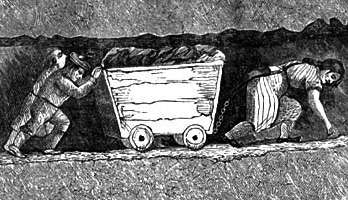Mines and Collieries Act 1842


Mines and Collieries Act 1842 (c. 99), commonly known as the Mines Act of 1842, was an act of the Parliament of the United Kingdom. It prohibited (banned) all girls and boys under ten years old from working underground in coal mines. It was a response to the working conditions of children revealed in the Children's Employment Commission (Mines) 1842 report. The Commission was headed by Lord Anthony Ashley-Cooper, 7th Earl of Shaftesbury.[1]
At the beginning of the 19th century methods of coal extraction were primitive and the workforce, men, women and children, laboured in dangerous conditions. In 1841 about 216,000 people were employed in the mines. Women and children worked underground for 11 or 12 hours a day for smaller wages than men.[1] The public became aware of conditions in the country's collieries in 1838 after an accident at Huskar Colliery in Silkstone, near Barnsley. A stream overflowed into the ventilation drift after violent thunderstorms causing the death of 26 children; 11 girls aged from 8 to 16 and 15 boys between 9 and 12 years of age.[2] The disaster came to the attention of Queen Victoria who ordered an inquiry.[1]
Lord Ashley headed the royal commission of inquiry which investigated the conditions of workers especially children in the coal mines in 1840. Commissioners visited collieries and mining communities gathering information sometimes against the mine owners' wishes. The report, illustrated by engraved illustrations and the personal accounts of mineworkers was published in May 1842. Victorian society was shocked to discover that children, as young as five or six worked as trappers, opening and shutting ventilation doors down the mine before becoming hurriers, pushing & pulling coal tubs and corfs.[3] Lord Ashley deliberately appealed to Victorian prudery, focussing on girls and women wearing trousers and working bare breasted in the presence of boys and men which "made girls unsuitable for marriage and unfit to be mothers". Such an affront to Victorian morality ensured the bill was passed.[1]
Clauses of the act
- No female was to be employed underground
- No boy under 10 years old was to be employed underground.
- Parish apprentices between the ages of 10 and 18 could continue to work in the mines [4]
References
- 1 2 3 4 The Mines Act, 1842, University of Paris, retrieved 2010-12-05
- ↑ Huskar Colliery Disaster (PDF), cmhrc.co.uk, p. 68, retrieved 2011-07-27
- ↑ Davies 2006, p. 17
- ↑ http://www.historyhome.co.uk/peel/factmine/minesact.htm
Bibliography
- Davies, Alan (2006), The Pit Brow Women of the Wigan Coalfield, Tempus, ISBN 0-7524-3912-X